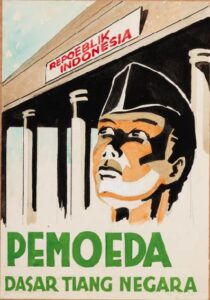The Indonesian Revolution and the United Nations
This page is the first of eight in a virtual exhibition on Frank Porter Graham’s role in negotiations for the recognition of Indonesian independence. See the homepage for the exhibition here. See the previous page here. See the next page here.
For both Indonesians and the international community, there was a strong push to solve the conflict between the Dutch (who wanted to re-occupy their former colony) and the Indonesians (who wanted recognition of their right to self-determination and independence) by diplomatic means. The world was already exhausted after a global conflict, the spirit of nationalism was on the march in Asia, and the new institution of the United Nations Organization needed to prove its capacity to solve armed conflict.

In fact, the Indonesian revolution was a determinative event in the early years of the UN (or, as it was known then, the UNO). Lester B. Pearson, an important world diplomat at the time and Prime Minister of Canada in the 1960s, noted
The Indonesian question was an early and difficult test for the new world Organization [the United Nations].[1]
Indonesia was an important case because it was the first instance where national self-determination came before the new body. Indonesia’s independence was not just a case of self-determination, though; it was also a new war Seeing the violence in Indonesia and the lack of intervention by a body supposedly created to guard world peace, Indian Prime Minister Jawaharlal Nehru asked,
What has become of the United Nations Charter?[2]
The first hurdle was that the Dutch claimed this was an entirely internal conflict, within Dutch territory, over which the UN would have no jurisdiction. When Egypt and other Arab nations formally recognized Indonesia’s sovereignty as a country in 1947, that allowed India and Australia to refer the question to the United Nations. On August 25, 1947, the Security Council passed a resolution
to tender its good offices to the parties in order to assist in the pacific settlement of their dispute in accordance with sub-paragraph (b) of its resolution 2 7 ( 194 7) of 1 August 194 7. The Council expresses its readiness, if the parties so request, to assist in the settlement through a committee of the Council consisting of three members of the Council, each party selecting one and the third to be designated by the two so selected.[3]

This Committee of Good Offices was set up quickly, with the Dutch nominating Belgium as a member, Indonesia nominating Australia as a member, and the Belgian and Australian sides choosing the United States as the third member.
This intervention by the UN was transformative, because it provided a viable diplomatic path to resolve the conflict. Until this time, the Indonesians focused much of their attention on guerrilla fighting. (In fact, many sectors of Indonesian society continued to push for a resolution on the battlefield instead of in the UN.) After this, leaders such as Prime Minister Amir Sjarifuddin and Vice-President Muhammad Hatta spent much of their energy in negotiations and public diplomacy. According to Ide Anak Agung Gde Agung, an official in the puppet state of East Indonesia at the time and later a Foreign Minister of Indonesia,
The resolution of the United Nations [in 1947 to mediate the Indonesian struggle for independence] changed the whole character of the Dutch-Indonesian dispute.[4]
[1] Lester B. Pearson, Foreword, in Alastair M. Taylor, Indonesian Independence and the United Nations (Ithaca, NY: Cornell University Press, 1960), xiv.
[2] Quoted in George McT. Kahin, Nationalism and Revolution in Indonesia (Ithaca, NY: Cornell University Press, 2018 [1952]), 215.
[3] United Nations Security Council Resolution 31 of 1947, available online at https://documents-dds-ny.un.org/doc/RESOLUTION/GEN/NR0/042/28/PDF/NR004228.pdf
[4] Ide Anak Agung Gde Agung, Twenty Years Indonesian Foreign Policy, 1945-1965 (The Hague: Moulton, 1973), 33.
Further Reading:
One of the American diplomats who worked on the question of Indonesian independence for the United Nations later published a complete study of the process: Alastair M. Taylor, Indonesian Independence and the United Nations. Ide Anak Agung Gde Agung also wrote on the UN intervention from an Indonesian perspective (although he was not an official of the Republic of Indonesia) in his book Twenty Years Indonesian Foreign Policy. For more on how the Indonesians sought (and gained) Arab recognition of their independence, allowing them to elevate their case to the UN, see Kevin W. Fogg, “Islam in Indonesia’s Foreign Policy, 1945-1950.” For a look at how the Australians and Indians took the case to the UN, Samuel E. Crowl has written an interesting perspective in “Indonesia’s Diplomatic Revolution: Lining Up for Non-Alignment, 1945-1955.”
The United Nations was not the only forum at which the Indonesians pressed their case. Sharinee L. Jagtiani has written about India’s support for Indonesia, and Indonesian lobbying at the Asian Relations Conference in Delhi in her article in Cold War History, “ ‘Foreign Armies Are Functioning on Asian Soil’: India, Indonesian Decolonisation and the Onset of the Cold War (1945–1949).” For a first-hand account of Indonesian public diplomacy with India, see Ali Sastroamijoyo’s memoir, Milestones on My Journey.
